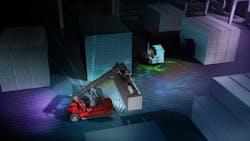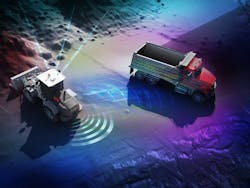Danfoss Looks to Overcome Labor Challenges with Autonomous Solutions
Automation is one of the many areas in which Danfoss Power Solutions is focusing its technology development efforts. The company’s PLUS+1 Autonomy solution brings together hardware and software to provide the various levels of automation OEM customers require.
During the 2022 Danfoss Distributor Meeting, Peter Bleday, Head of Autonomy at Danfoss Power Solutions, outlined the five levels of autonomy, all of which Danfoss is developing technology for:
- Reduce the load on the operator.
- Some functions are automated or combined.
- Vehicle performs key functions, operator is there for some safety.
- Vehicle performs most functions, operator can take over if needed.
- Vehicle performs all functions, operator is not needed.
The third level is where Danfoss is currently focusing much of its development efforts; it is the level at which the vehicle starts to make decisions for the operator said Bleday.
This capability is becoming increasingly important in many off-highway mobile equipment applications, such as construction and agriculture, as a means of helping overcome the skilled labor shortage. Use of automation can also help to improve efficiency and productivity by ensuring work is completed consistently and accurately.
Power & Motion had the opportunity to speak with Bleday at the distributor meeting about Danfoss’ automation technology developments as well as trends the company is seeing in this area.
*Editor’s note: Questions and responses have been edited for clarity.
Power & Motion (PM): What prompted Danfoss to get into the field of autonomy and what is the benefit of doing so?
Peter Bleday (PB): In early 2017, [we were] just starting to see the need for autonomy from the OEMs’ perspective, and we actually started with a prototype a small R&D team. That team was the DAVIS team, the Danfoss Autonomous Vehicle Integration System [which] was built for a prototype at Agritechnica in 2017. And from there, for the next 2-1/2 years the R&D team stayed together and kept kind of developing. In early 2020, we sat down and said, “Okay, what is driving the market? Is autonomy going to be a major thing? And if so, how should Danfoss provide products to OEMs and distributors?”
Because when you say autonomy, it's such a wonderfully big topic. So, we sat down and really said, “Okay, this is how we're going to go about it and we can provide a lot of software capability.” I think the Lego building blocks is my favorite [analogy]…we can provide either the Legos to you and you can build it yourself, or we can build it for you and go about it that way.
A lot of what we've seen, especially in our markets, like agriculture, there's a huge lack of skilled labor. I was out in California [in] October of last year, and typically they have about 200 people to harvest these large strawberry fields. We were talking to a farmer out there and he had 45-50 [people] that had actually shown up; he wasn't going to be able to harvest his whole field before the crop went bad. We've seen that [challenge] pushed up to the OEMs because then it's “How can I build a vehicle that does this? Or can be more productive?” The OEMs, a lot of them, especially the smaller ones, they can't do that [autonomy] themselves. And so that's what's really driven us to say we can build the whole solution here.
PM: Does Danfoss see agriculture as a key application area or market that really needs autonomy? You were talking in your presentation [at the Danfoss Distributor Meeting] about the various areas the company works in but is agriculture a key focus area?
PB: There’s really three reasons why agriculture [is a focus] and I’ll start with the reasons why not mining and material handling. A lot of those are very vertically integrated. In all honesty, Rio Tinto owns the mine and they own everything about the mine. For them, they work with a Caterpillar to come in to maybe do the vehicles but they’re doing the whole site and it’s very vertical and a big project. Same thing with warehouses with Amazon Robotics and companies like that.
But in agriculture, there is no big Rio Tinto-style end user that can really integrate a field like that or a whole site. Also, when you look at food supply from a [global] perspective, Canada before the pandemic left over $3 billion worth of crops in the field in 2019. And that was just due to the lack of labor [which] goes to the lack of food supply. So for us, agriculture is absolutely a priority; airport ground support as well has been a priority. You’ve seen all the cancellations and issues there are and so those two industries are where a lot of our mid-sized OEMs are; OEMs that don’t have a team of 500 people like a John Deere does to do this by themselves where we can leverage what we have to help them the most.
PM: You were saying during your presentation Danfoss does indoor and outdoor capable systems. Are there many differences in how you develop the systems for machines that would work in those environments?
PB: The biggest difference is how the machine localizes and figures out where it is. Outdoors [there is GPS]…we actually use a lot more sensors fused together to figure out position more accurately. But at the end of the day GPS is pretty widely available worldwide. Indoors there is no GPS, and it is very relative to your environment. If you’re in [a building] you only need to know what it looks like, you don’t need to know what a building down the street looks like. It’s a different kind of problem, and one that’s a little bit harder to solve and harder to solve at a scale where we can work with an OEM who’s going to deploy their vehicles to 20 or 50 different buildings. The indoor navigation piece is something we wanted to take on right away. Luckily, we do have a lead customer we’re working with on that.
For indoor there’s a software solution that we’re working on that somebody can use to localize themselves. But if there is a Wi-Fi or ultra-wideband network, we can now integrate into those. There’s a lot of different technologies…our goal isn’t to be the provider of all [the components]; our goal is to really help integrate the system together.
PM: Could you talk a little bit about those industry partnerships Danfoss has with some of the sensor manufacturers and how the company goes about doing those? What is that partnership like?
PB: One thing we realized is that the breadth of applications that our distributors see, let alone what we see across all of them, is so wide that no one single sensor is like the Holy Grail of sensors. There's different needs in different places…people ask about dust or airports…we use different sensors [for all of those situations]. And one of the things we realized early on was, we're not going to make the killer app version of that sensor, so why don't we just go find the companies that really do it well and do it ruggedized and build it out. And so, our partnerships are all a little bit different in how they are but one of the key factors is we don't just buy that product and resell it. What we do is, literally in some cases, carry the business cards of our partners with us and when we talk to one of our customers, we'll say based on your application, this is going to be the right sensor for you. Here's the person you need to call to get that sensor because they have their own field support teams. They have their own way to support it, and that's the way that OEM or distributor is going to get their best support is going to be through that partnership as opposed to calling us and us having to call somebody else.
PM: And are these partners helpful too as Danfoss is building the software and everything, and providing their input?
PB: Generally, with the partnerships, there's engineering work in both directions in that we have to build the full integration for them to integrate [into]. It's much more work than you would think it is; you think it's just plugging in the radar, but it's actually a significant amount of work, especially to make sure you're getting the right fault codes and safety systems and all of those things off of those sensors. The other thing we work with them on is we do want to be use experts or field experts with their sensors in terms of how we set them up and how we get them on the vehicle. In the integration [phase] there’s engineering work that goes in both directions—our team [spends] several thousand hours of development [time] to get drivers up and built, but also them helping us with their firmware and all of their software as well.
READ MORE about Ouster, one of Danfoss' industry partners, and its digital lidar technology.
PM: And how or where does autonomy and hydraulics systems possibly play together?
PB: What I would say is autonomy is not a part, it’s very much a system-level problem. When you look at things like our EHi steering valves which are electrohydraulic, steer-by-wire technology, we have to have steer-by-wire on the autonomy side. We play with the full system and suite of products. We’re able to use our E-Steering, we’re able to use our hydraulics…and because all of those are electronic and software controlled, now we can add the autonomy to it. With a lot of the hydraulics products being digitally controlled, that’s what does the physical work at the end of the day so that interface is key.
PM: What have been some of the biggest challenges or learnings Danfoss has had while developing these autonomous systems?
PB: Again, autonomy is a system-level problem, and every problem is a little bit different. Danfoss is traditionally a component supplier and less of a full-service system level provider. We’ve done some of that work before but typically that’s confined at the larger OEMs. We’ve learned a lot in how to get into real-world projects with companies and really be able to execute. Every time we’ve done a project and gotten in with a customer we’ve learned [something]. One of the things we’ve learned is the goal isn’t just to get the catalyst prototype. Our goal is to work with the customer to get them to production. And that’s a whole different problem because you’re not just doing a demo. You’re trying to get a whole solution together that makes sense for them, for their industries, for their customers and get it into production. Basically, the design phase with the OEM all the way through the supporting phase, there’s a lot of learnings to do when you’re involved with an OEM that early in the process of designing a vehicle.
PM: And is that beneficial to be working with the OEM early on in the process?
PB: Absolutely. I think one of the biggest benefits that we see is, we're in with their product teams in the ideation which helps our software engineers to understand exactly what the problem is. And that's why we have people…who have these big SAE backgrounds. They understand the whole system, they understand the application, they can sit down with the OEM very early on before any lines of code are written or wires run or steels molded. And they can really work through that whole process. It helps us to understand the application too, because at the end of the day, you can do a lot of cool engineering, but that's not what the OEM or the customer wants. They want the solution.
PM: Are there specific types of automation features Danfoss is finding OEM customers are specifically looking for right now?
PB: Our obstacle detection is kind of our biggest thing…[enabling] blind spot and also obstacle avoidance. It's something that's starting to become more common even on cars. But I think one of the things that we're realizing is, we talked about the lack of labor, but there's also a lack of the skilled labor. You have the person who drove the machine for 30 years, now they're not in the machine anymore. The next person's driven it for a total of 30 days. How do we prevent that person from running into things? We've seen a lot of these operator assist features that are preventing collisions or maybe adding a little bit more precision or capability; we've seen a lot more of those applications.
Also, we've seen a lot of applications that are highly manual but intensive work where you're not really replacing a person's job…we have a published video for Vinergy where a grape cart carries about 1,000 lbs. of grapes in and out of the field. Before, you'd have four people with 250-lb. wheelbarrows trying to push those in and out of the field. Now those four people, it’s not like they’re gone, they’re now just picking the grapes letting the cart run in and out. sound like they're gone. They're now just picking the grapes and letting the cart running is great. So overall, it's more productive, it's more ergonomic on people's backs. Those are really the two biggest applications we've seen.
PM: What does Danfoss foresee as the next steps of autonomy or when could full autonomy possibly become a reality?
PB: I think it's going to vary industry by industry. I think you look at mining and material handling and look at a company like Amazon or Walmart or Target – they’re already 70 or 80% autonomous and to the point where they have segmented off fully autonomous areas. Amazon just released their fully autonomous robot so the technology is getting there. In an Amazon warehouse or in a Walmart warehouse, they control that environment. Same thing with a mine, they control that environment. Those are, again, highly vertically integrated, and they’re going to be the first ones to be fully autonomous.
But as you move more toward agriculture and ground support, you will eventually get to Level 5 but I don't think it's a question of technology. I think it's a question of is a farmer going to leave the field during harvest? I don't think so. He might have five vehicles working for him, but that's still the major money-making moment for [a farmer]. Is the FAA ever going to allow there to be nobody around the airplane? I don't think so. You’ll still have that one operator but maybe with multiple vehicles that are doing different things. The technology is getting here; I would say you're going to see a lot more Level 3 cases. And I still think you'll probably see Level 4 in off-highway before you really see it fully adopted on-highway because the use case is just different.
PM: To wrap up our conversation, what is the coolest thing you’ve seen happening in autonomy for either off-highway or another type of application?
PB: A lot of the stuff that we get to work with…the things coming out of our systems and R&D teams. We have a lot of people that are former on-highway that have come over, they're always impressed with the capabilities we have. But I'm always amazed at what the machine learning teams can do. It's really fun to see when someone brings a use case to the software developers and the R&D engineers and they say here's what I can do with it. The marrying of that technology to the application I think has been the most fun.
For me, in terms of the industry, it's nice to see all of the advancements. We're members of Mass Robotics, which is the largest robotics incubator in the world, and we're able to work with them and see interesting things. I think it's kind of interesting to see all that and to be working on it, and to be able to sit there and say, “I know how that works.”






